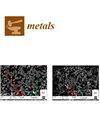烧结温度对制动片用铜基复合材料微观结构及机械和摩擦学性能的影响
IF 2.5
3区 材料科学
Q3 MATERIALS SCIENCE, MULTIDISCIPLINARY
引用次数: 0
摘要
铜基粉末冶金材料常用于制造高速列车的刹车片。制备过程包括混合、球磨、压制和烧结。在这些步骤中,热压烧结是一种快速高效的方法,对产品的性能和表现有显著影响。本研究采用热压烧结法制备了四种样品(S700/S750/S800/S850),烧结温度各不相同,具体如下:700 ℃、750 ℃、800 ℃ 和 850 ℃。测试了四种样品的机械和物理性能,并使用扫描电子显微镜、能量色散光谱仪和 X 射线衍射仪研究了其微观结构和成分。研究结果凸显了烧结温度与样品机械和物理特性之间的密切关系,因为烧结温度会影响颗粒的孔隙率和界面结合力。值得注意的是,样品 S800 具有优异的机械和导热性能。此外,还测试了四种样品在 150 公里/小时至 350 公里/小时的不同制动速度下的摩擦系数(COF)、摩擦热和磨损率。结果表明,四种样品的 COF 在 300 km/h 以下保持相对稳定,但在 300 km/h 以上由于热衰减而明显下降。S800 样品在不同的制动速度下显示出一致的高 COF 值,磨损率最低。观察到的磨损机制包括磨料磨损和氧化磨损。此外,摩擦试验结果表明,S800 的 COF 曲线与中华人民共和国铁道部的标准非常接近。本文章由计算机程序翻译,如有差异,请以英文原文为准。
Effect of Sintering Temperature on the Microstructure and Mechanical and Tribological Properties of Copper Matrix Composite for Brake Pads
Copper-based powder metallurgy materials are frequently utilized in fabricating brake pads for high-speed trains. The preparation process involves mixing, ball milling, pressing, and sintering. Among these steps, hot-pressed sintering stands out as a rapid and efficient method that significantly influences the properties and performance of the products. In this study, four samples (S700/S750/S800/S850) were prepared using hot-pressed sintering at various temperatures, as follows: 700 °C, 750 °C, 800 °C, and 850 °C. The mechanical and physical properties of the four samples were tested, and the microstructure and compositions were investigated using scanning electron microscopy, energy dispersive spectroscopy, and X-ray diffraction. The findings highlighted the close relationship between sintering temperature and the mechanical and physical properties of the samples, as it impacts the porosity and interfacial bonding of the particles. Notably, Sample S800 demonstrated superior mechanical and thermal conductivity. Furthermore, the coefficient of friction (COF), friction heat, and wear rate of the four samples were also tested under different braking speeds ranging from 150 km/h to 350 km/h. The results indicated that the COFs of the four samples remained relatively stable below 300 km/h but decreased notably above 300 km/h due to heat fading. Sample S800 displayed consistent and high COF under varied braking speeds and exhibited the lowest wear rate. The observed wear mechanisms included abrasive wear and oxidation wear. Additionally, the friction test results underscored the close correspondence of the COF curve of S800 with the standard of the Ministry of Railways of the People’s Republic of China.
求助全文
通过发布文献求助,成功后即可免费获取论文全文。
去求助
来源期刊

Metals
MATERIALS SCIENCE, MULTIDISCIPLINARY-METALLURGY & METALLURGICAL ENGINEERING
CiteScore
4.90
自引率
13.80%
发文量
1832
审稿时长
1.5 months
期刊介绍:
Metals (ISSN 2075-4701) is an open access journal of related scientific research and technology development. It publishes reviews, regular research papers (articles) and short communications. Our aim is to encourage scientists to publish their experimental and theoretical results in as much detail as possible. Therefore, there is no restriction on the length of the papers. The full experimental details must be provided so that the results can be reproduced. Metals provides a forum for publishing papers which advance the in-depth understanding of the relationship between the structure, the properties or the functions of all kinds of metals.
 求助内容:
求助内容: 应助结果提醒方式:
应助结果提醒方式:


